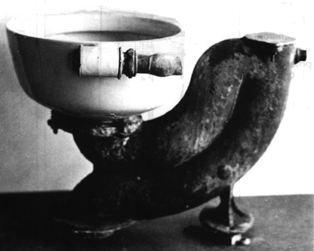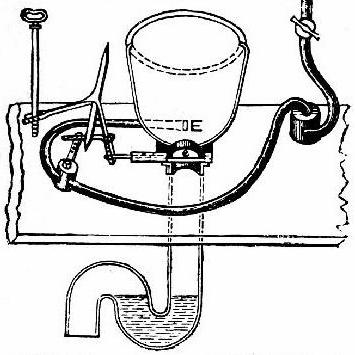courtesy of Plumbing & Mechanical Magazine, July 1994
They were the Bill Gates and Steve Jobs of their day. They were the ones who tinkered alone and envisioned a world well beyond the grasp of their contemporaries.
They were the toilet makers – the men who understood with incomplete knowledge that there was a better way than chamber pots and open trenches, and set about finding it. They labored long hours, usually alone and for little reward. In some cases, there was no reward, just ridicule for an invention too far ahead of it’s time.
The English Origins: There was a noble origin to the water closet in its earliest days. Sir John Harington, godson to Queen Elizabeth, set about making a “necessary” for his godmother and himself in 1596. A rather accomplished inventor, Harington ended his career with this invention, for he was ridiculed by his peers for this absurd device. He never built another one, though he and his godmother both used theirs.

Two hundred years passed before another tinker, Alexander Cummings, would reinvent Harington’s water closet. Cummings invented the Strap, a sliding valve between the bowl and the trap. It was the first of its kind. However, it didn’t take long for others to follow Cummings lead. Two years later in 1777, Samuel Prosser applied for and received a patent for a plunger closet. On his heels came Joseph Bramah, only one year later. His closet had a valve at the bottom of the bowl that worked on a hinge – a predecessor to the modern ballcock. Himself a bit of a sailor, Bramah’s closet was used extensively on ships and boats of the era.
The master toilet maker among the Englishmen would emerge in the next decade. Thomas Twyford revolutionized the water closet business in 1885 when he built the first trapless toilet in a one-piece, all china design. A preeminent potter, Twyford competed against other notable business including Wedgwood and Moulton.
Twyford’s design was unique in that it was of china, rather than the more common metal and wood contraptions. The internal workings of his water closet were the work of one the first pioneers of the “sanitary science.” J. G. Jennings patented a washout closet in 1852. This unit had a shallow basin with a dished tray and water seal. The flush water drove the contents into the pan and then through the S-trap. It was a design the Twyford would refine and promote for the rest of the decade.

On American Shores: The work of the English inventors didn’t travel with settlers to the new world. The only item to make the journey was a chamber pot, so American inventors were on their own.
On their own, yes, but not very far behind. In fact water closet developments in the new world paralleled inventions in the mother country. First it was the conical – shaped hopper set in a lead trap that was placed under the floor. The pan closet came next. It improved on the previous model with an upper ceramic basin and a shallow copper pan with three to five inches at the base. A wash down closet flushed by a direct line from a storage tank hidden high above, usually in the attic.
The first Americans awarded a patent for a water closet are James T. Henry andWilliam Campbell. In 1875 their plunger closet resembled some of the twin-basin water closets developed and derided in England. These units were less than sanitary and shunned by some of the industry’s earliest pioneers.
From the late 1850s to the mid 1890s the number of patents granted for water closet designs grew as more and more inventors realized the potential market for an improved model. An American, John Randall Mann was granted a patent for his three-pipe siphonic closet in 1870. In 1876 William Smith earned his own for a jet siphon closet. This model caught the attention of the famous American sanitary engineer George Waring who developed it into larger pieces of sanitary ware, as it was then called.
Thomas Kennedy, another American improved on Mann’s designed and patented a siphonic closet which required only two delivery pipes. One flushed the rim and the other started the siphon. Still further improvement occurred in 1890 with William Howell’s water closet that eliminated the lower trap, but maintained the same superior function.
By the turn of the century water closet innovations were occurring on a nearly daily basis. The U.S.Patent Office received applications for 350 new water closet designs between 1900 and 1932. Two of the first granted in the new decade were to Charles Neff and Robert Frame. These New Englanders were the first to produce a siphonic wash-down closet that would become the norm in this country in later years.
Problems with the bowl design in Neff and Frame’s unit were fixed 10 years later by Fred Adee. He redesigned the bowl, eliminating the messy overflows that sometimes occurred, and in doing so gave birth to production of the siphonic closet in America.
Some of the names of the other inventors who refined water closet design at this time have been lost, but their accomplishments have not. In the early 1900s patents were granted for the flushometer valve, a backflow preventer, a wall-mounted closet with a blow-out arrangement, a tank that rests on the bowl, and reverse trap toilets.
Modern Age Inventors: This isn’t tosay there aren’t inventors alive and working today who will be added to this list of who’s who in the years to come. However,some of the modern day water closet wonders aren’t plumbers or evenp lumbing engineers.They’re scientists working on motors to create the “jet flush” toilet.
Engineers at the Emerson Motor Company in St. Louis have developed a 3.3 inch motor and a .2 horsepower pump that fits in a toilet tank to add speed and power to each flush. These motorized toilets incorporate a steeper bowl than other gravity style toilets to allow waste water to flow out easier. A slanted bowl and pressurized flush also allow the system to employ less water than a traditional gravity-flow toilet. To operate, the unit is plugged into a standard outlet in the bathroom. To date, Kohler Co. is the first plumbing manufacturer to market this technology .
Motors are impacting plumbing in other ways too. Emerson partnered with pump manufacturers Zoeller Company and Hydromatic Pump Company to develop a plumbing system that liquefies waste. A pump is positioned in waste water pipes below the toilet and allows fixture manufacturers to meet existing water consumption requirements by chopping waste into a liquid consistency. As waste moves through the system, a 5.5 inch, high-torque motor drives a sharp tooth pump (much like that on a garbage disposer) that chops waste and toilet paper and pushes the resulting slush through the waste water system.
Who Can Resist? How complete would an article on the men behind the water closet be without at least one mention of Thomas Crapper? For a individual who had little or nothing to do with inventing the water closet, he has become a modern age folk hero. Despite all the evidence, people who should know – as well as those who don’t – continue the tale of Thomas Crapper as the man who “invented the toilet.”





#
This is nice